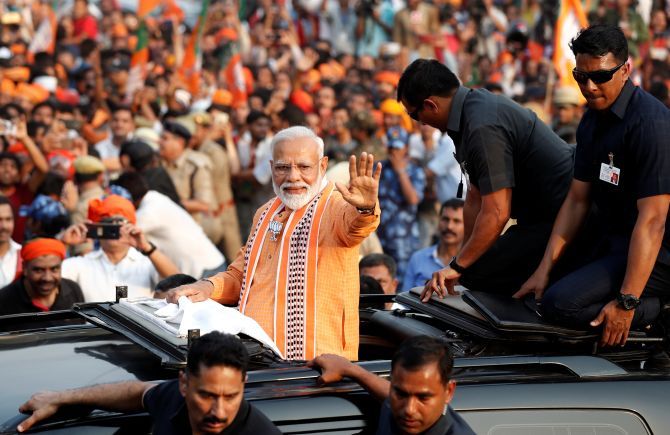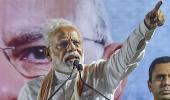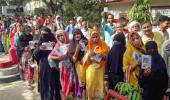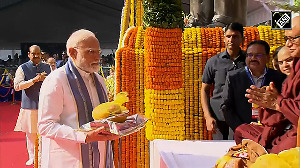'If Mr Modi continues growing as a Hindu Hriday Samrat, better that it is done by restoring ancient temples than demolishing medieval mosques,' says Shekhar Gupta.

Writings on the Wall is a metaphor that grew out of my travels, mostly through the poll-bound regions of India and the neighbourhood over the past 15 years.
Because, even more than its big festivals, the subcontinent comes to life during its elections.
And what's on people's minds, their aspirations, joys, concerns and fears, you can pretty much understand by reading these writings on the wall.
These can be graffiti, advertising, skylines, fences, or, even rubble.
You want to see change in Varanasi, you walk on fresh rubble, a lone bulldozer is labouring on yards away, and look at the walls.
Don't read. Because there is nothing to read.
Just take a close look at the remnants of what used to be there.
These are remnants of doors, windows, ventilators, cupboards, as if these were pasted on these walls with some adhesive and somebody rudely pulled them out.
If you were airdropped here, you might for a moment think you've landed in the middle of some zany art installation.
Or, it could also be the setting of another madcap Fevicol ad: You join two houses with it, knock them with a bulldozer, our joints will survive.
This is precisely what has happened here.
About 300 houses, temples and other buildings stood in this area of just 4.6 hectares (11.4 acres), most of them so close to each other that over time they had become conjoined as if constructed together.
Beneath these somehow survived Varanasi's famous -- or infamous -- byzantine galis (lanes), some so narrow that not more than two average-sized adults could pass them.
It's now history.
Modi critics say that the cloistered neighbourhood that concealed the Kashi Vishwanath temple, among Hinduism's holiest and oldest, has been broken down so the entire Hindu world could now see the temple from the ghats of the Ganga.
More important, as they see the relatively modest temple, they will notice the more imposing domes of the Gyanvapi mosque, which Aurangzeb apparently built in 1669 after demolishing the original Kashi Vishwanath temple.
This will be militant Hindutva's eyesore and next target.
I would find it less alarming and not just because officials, including Vishal Singh, 36, chief executive officer of the Kashi Vishwanath Development Authority, remind me that the mosque is already well-protected with 30-foot-high solid steel pillars and CRPF armed with automatics.
Mine is a realistic view that even if the rulers of the day were violent majoritarian malcontents and the institutions had become so malleable that they could no longer protect the Constitution, a building with easy access and view will be harder to harm than one hidden in a maze.
So, just the redevelopment of the area, clearing of the 300 metres to the riverfront for an unhindered view of the temple from the ghats and vice-versa, doesn't add to the threat.
Some local Muslims leaders filed a petition in the Supreme Court, expressing these apprehensions on behalf of the Anjuman Intezamia Masjid, but it was rejected.
The greater opposition, in fact, comes from Varanasi's Hindu conservatives.
Walk down the narrow lane connecting the temple precinct's Neelkanth gate to the holiest Manikarnika Ghat, where cremations take place, and we run into well-known local writer and journalist/intellectual Trilochan Prasad.
He's furious.
Who can dare to change what was never destined to change? They have destroyed our heritage, everything that was sacred, hundreds of crores have been wasted, a way of life has been destroyed and more.
Like him or not, Narendra Damodardas Modi is a risk-taker.
This -- the redevelopment of a mere 4.6 hectares, involving the demolition of 296 buildings -- is among the greatest risks he has taken in his constituency.
Because this means annoying not just the liberal, but the most conservative residents of the Brahmin heartland, which takes pride in being eternal and unchanging.
Almost 90 per cent of those shifted are Brahmins.
Like its priests, Varanasi also must have the highest per capita population of political pundits.
And many would tell you, with the greatest conviction, that this Modi-Yogi 'misadventure' will cost them anything between 60,000 and 75,000 votes.
To understand the before-and-after you need to see the charts and plastic models in the office of CEO, who, incidentally, has a master's in administration from the University of Maryland.
A sum of Rs 600 crore has been sanctioned for the authority and the old buildings acquired after making a law in the UP assembly.
The owners have been given twice the circle rate and they seem happy by and large, with a total of a little over Rs 200 crore paid out.
Another Rs 15 crore has been paid to residents who didn't own the buildings but claimed tenancy rights.
Only 12 owners are still holding out, in the vicinity of the temple.
Demolition work is mostly over.
Mr Modi performed the bhoomi pujan for the new precinct on March 8 and work should finish in another year or so.
By now 43 temples have been discovered, entombed earlier in houses built over them, mostly as encroachment.
When it is completed, this temple complex will become what almost nothing in old Varanasi can still claim to be, even after five years of having the prime minister as its MP: Clean, modern, and accessible.
The point is, was it a risk worth taking?
Inner city development is one of India's greatest challenges.
Most of our leaders have stayed clear of this minefield.
The first who attempted it was a reckless tyrant who asked no questions (Sanjay Gandhi, Turkman Gate and Jama Masjid) and the other is the spiritual head of his sect whom nobody would ask a question: The Syedna of the Bohris now leading the Rs 4,000 crore rebuilding of central Mumbai's Bhendi Bazaar.
Mr Modi is the third, but the first to try and do this using the laws, persuasion, and a wide open purse.
While we question his commitment to secularism and often enough expose the hollowness of his sab ka saath, sab ka vikas slogan, we also need to acknowledge that in some important ways he has challenged Hinduism's social conservatism.
The Swachh Bharat and anti-open defecation campaigns are one aspect of it.
The other, forgotten by now, was his removal of a large number of temples encroaching public spaces in Gujarat, which put him at odds with his original VHP hatchet-men.
The Kashi Vishwanath Corridor is his panga with Varanasi's conservative Brahminism.
Many wise and famous men have spoken immortal lines about Varanasi.
Probably the most quoted are Mark Twain's: 'Benaras is older than history, older than tradition, older even than legend and looks twice as old as all of them put together.'
But must it continue to be twice as messy and filthy as that? Surely, Hinduism deserves better for its holiest, oldest city, supposedly of salvation.
Twain would be surprised reading the walls around the new, bulldozed emptiness at the temple today.
They speak of change.
Few doubt that Mr Modi will be re-elected in Varanasi.
We will also be able to guess on May 23 if it makes Mr Modi lose those tens of thousands of conservative votes pundits of Banaras predict.
But in a year, if he completes the project, it could work wonders with his much larger, pan-national Hindu constituency.
And you know what, I'm happy to say I am enthused by this project.
It will be a great precedent for other old cities, hopefully for the restoration and pedestrianisation of Delhi's Chandni Chowk to its old glory.
And if Mr Modi continues growing as a Hindu Hriday Samrat, better that it is done by restoring ancient temples than demolishing medieval mosques.
By Special Arrangement with The Print












 © 2025
© 2025